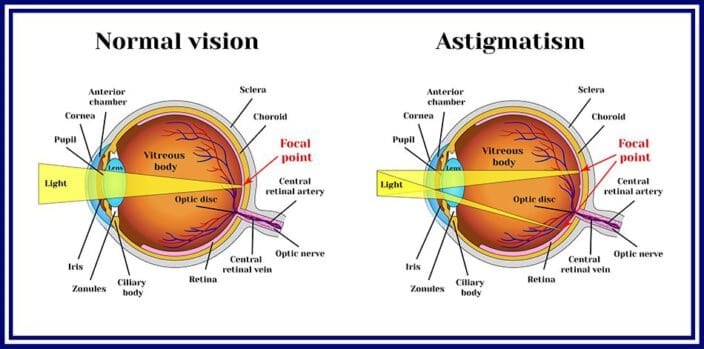
Medically Reviewed by Angelique J. Pillar, M.D.
Is There a Cure for Astigmatism?
Home / LASIK for Astigmatism /
Last Updated:

Medically Reviewed by Angelique J. Pillar, M.D.
As far as correcting the condition goes, the short answer is “yes,” LASIK surgery can cure astigmatism and has done so for thousands of patients. Patients report a satisfaction rate between 92% and 98%.
That doesn’t mean that LASIK is for everyone anyway. Like any surgery, LASIK carries some risks and downsides. It is often a very invasive, involved, and uncomfortable procedure. There is always that chance of complications requiring follow-up adjustments. When considering getting surgery, you should weigh the overall affect on your quality of life.
By most estimates, astigmatism affects some 40% of the population to various degrees. Astigmatism is a refractive error caused by a cornea or lens that has an irregular shape, so light is refracted poorly onto the retina. When addressing astigmatism, many people turn to glasses or contact lenses, but if you are looking for a solution on how to correct astigmatism, either LASIK (laser-assisted in situ keratomileusis) or PRK (photorefractive keratectomy) can be an option.
Table of Contents

What Is Astigmatism and Can It Be Corrected?
Refractive errors like nearsightedness, farsightedness, and astigmatism blur your vision and make seeing at certain distances difficult. If your eye has an irregular shape, causing general blurry vision, you have astigmatism.
Astigmatism can apply to just the cornea, or the lens just underneath it, either of which can be shaped irregularly.
You deserve clear vision. We can help.
With 135+ locations and over 2.5 million procedures performed, our board-certified eye surgeons deliver results you can trust. Your journey to better vision starts here.
Astigmatism is typically treated with corrective eyewear like glasses or contact lenses. Like other refractive errors, this condition is very common and easy to diagnose and treat. If you have untreated astigmatism, you will struggle with blurry vision, and you may also suffer from headaches, eyestrain, squinting to see clearly, and eye discomfort.
While your optometrist will typically prescribe either glasses or contact lenses to compensate for the irregular shape of your eye and improve your vision, you may also consider a laser refractive surgery to correct the shape of the cornea. In most cases, this operation can completely correct astigmatism, effectively curing it.
How to Correct Astigmatism with Laser Surgeries
Not everybody with astigmatism opts for surgery, even though it is treatable like all refractive errors. Corrective eyewear such as contacts and glasses go a long way towards compensating. For everyone else, there’s laser-assisted surgery. These come in two kinds, LASIK and PRK.
LASIK
Laser in situ keratomileusis (LASIK) is a widely used type of laser surgery which has helped people around the world achieve clearer vision by reshaping the cornea. A laser device will shave off a few layers of the cornea, which is over the pupil outside the eye. The process does not take long, and many refractive errors can be fixed, including astigmatism. Since astigmatism involves an irregularly shaped cornea, reshaping this small part of the eye will improve vision. You may not achieve 20/20 vision, but you can achieve enough visual clarity (typically 20/40 or better) to perform most activities without needing glasses or contact lenses.
There are some instances when LASIK may not be right for you. You and your ophthalmologist may decide it’s not the ideal option for you if:
- You have a disease or take a medication that can affect wound healing – LASIK is an intensive process
- Your career prohibits refractive procedures, or you are in a very physically demanding field – LASIK takes a long recovery period
- You changed your glasses prescription in the past year, indicating that your eyes are still changing too fast for LASIK to work – there’s no sense trying to precision-adjust a lens that’s going to deteriorate further
- You have thin corneas – you need some corneal tissue to work with
- You have already had a LASIK procedure in the past – scars can build up over repeated surgeries
- You are under age 18 – most surgeons recommend not attempting LASIK until your early 20s
- You are pregnant – Hormonal change makes the eyes fluctuate, plus the eyedrops you take during recovery can affect breast milk
Otherwise, as long as your astigmatism does not exceed 3.0 diopters in magnitude, then chances are good that LASIK will work for you. If not, there might be PRK.
PRK
Photorefractive keratectomy (PRK), like LASIK, uses a guided laser to shape off some layers of cells of the cornea, creating a regular shape that refracts light correctly onto the retina. As a result, this leads to clearer vision, usually 20/40 or better. While PRK is less popular than LASIK, it is also an effective treatment for refractive errors, including astigmatism. PRK is a better treatment for people who have chronic dry eyes or thin corneas. Unlike LASIK, PRK does not require cutting a flap in the cornea, so you are less likely to dislodge this flap later or have an over-correction when too much of the inner cornea is removed.
Also as with LASIK, there are some conditions that prevent you from being a good candidate for PRK. You and your ophthalmologist may decide it’s not the ideal option for you if you don’t meet LASIK conditions plus:
- have advanced glaucoma
- have cataracts
- have uncontrolled diabetes
- have eye infections or a history of same
Like LASIK, PRK can successfully correct astigmatism, effectively curing it.
Other Types of Surgery For Astigmatism
The options don’t stop with just LASIK and PRK. There are several operations that can clear up astigmatism for good.
- LASEK (laser-assisted subepithelial keratectomy) – A slightly less invasive version that can allow laser-reshaping of the cornea without cutting into eye skin, maybe suitable for people disqualifying for LASIK
- Epi-LASIK – Another less invasive version of LASIK using a different method of penetrating the epithelial skin cells to access the cornea, with less pain and quicker recovery
- SMILE – Small Incision Lenticule Extraction – Another, newer innovation in eye surgery, this method also attempts to be minimally disruptive which removing excess corneal cells through a much smaller incision
- RLE – Refractive Lens Exchange – If it’s no good repairing your eye lenses, how about swapping them for bionic implants instead? This procedure involves removing the natural lens of your eye and replacing it with a clear toric intraocular lens (IOL) with a different lens power to correct your vision.

Your Astigmatism May Not Need Any Treatment
As mentioned earlier, one should take into account their overall quality of life and how surgeries can impact them. Not everyone is comfortable having their eye parts reshaped by laser. It can be a trying process involving extended aftercare, many tests, and some discomfort. Not every surgery is guaranteed to have perfect results, and you can basically only do LASIK once.
Many people are satisfied with glasses or contact lenses if they need vision correction. In some cases, an optometrist may diagnose a mild astigmatism, but the condition does not require any type of vision correction. If toting glasses around and having to squint at the occasional line of fine print is a compromise you’re more than happy to make to avoid eye surgery, you might be happy living with mild astigmatism if it’s not encumbering your life.
For the rest of astigmatism cases, the various eye surgery procedures do mean freedom from corrective eyewear and better long-term results. In the more severe cases of astigmatism, surgery provides a considerable relief from living a life near-blind. Relatively speaking, laser eye surgery is a short procedure with minimal recovery time, so it might be your best option in the long run.
You deserve clear vision. We can help.
With 135+ locations and over 2.5 million procedures performed, our board-certified eye surgeons deliver results you can trust. Your journey to better vision starts here.
References
- What Is Astigmatism? American Academy of Ophthalmology (AAO).
- Astigmatism. (June 2019). National Eye Institute (NEI).
- Astigmatism. (September 2019). Mayo Clinic.
- LASIK. (March 2018). U.S. Food and Drug Administration (FDA).
- Can LASIK Fix Astigmatism? (March 2018). All About Vision.
- When is LASIK Not for Me? (July 2018). U.S. Food and Drug Administration (FDA).
- What Is Photorefractive Keratectomy (PRK)? (September 27, 2017). American Academy of Ophthalmology (AAO).

Angelique J. Pillar, MD is a fellowship trained and board certified ophthalmologist specializing in cataract, cornea, and refractive surgery.
This content is for informational purposes only. It may have been reviewed by a licensed physician, but is not intended to serve as a substitute for professional medical advice. Always consult your healthcare provider with any health concerns. For more, read our Privacy Policy and Editorial Policy.